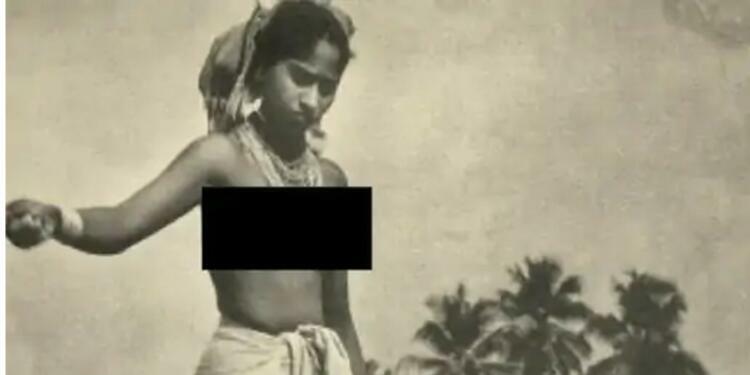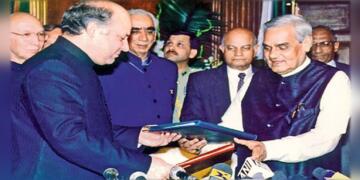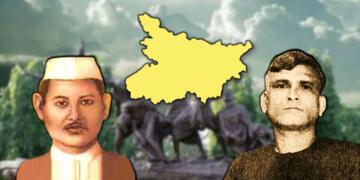Remember Pirates of the Caribbean? In the movie, the heroine, Elizabeth is presented with a particular garment called a corset, which her father, Governor Swan, yells, ‘the latest fashion in London’. But as soon as she wears it, Elizabeth suffocates, and she faints before she can speak to her fiancé.
The dichotomy between Raja Ravi Varma’s society and the imperial one
You must be thinking why am I discussing this with you? Today, the western culture that teaches us the lessons of modernity gives us long lectures on patriarchy, this is the same orthodox western world, that once called their women ‘witches’ on suspicion, and used to give death penalty. They used to torture them in such a way that even you would think – were they actually humans? We will explain how the Europeans, especially the British imperialists, imposed their ill-fated patriarchy on Kerala. From then on, it gradually became a part of the whole of India.
In an earlier article, we introduced you to how Raja Ravi Varma was looking for a bride for his nephews. Raja Ravi Varma had two nephews, one of whom looked exactly like the one you saw in the portrait of Raja Ravi Varma. A great scholar of theology, versed in ethics, this person’s name was Raja Raj Varma, and his cousin was Raja Ram Varma, who was certainly well versed in ethics and religious science. But in terms of beauty, there was no competition between him and Raja Raj Varma.
Read more: The story behind Raja Ravi Varma’s “Rama”
Matriarchy not Patriarchy in Kerala
When Travancore’s princess was asked to choose her groom, think, what would have been her option? According to you, there would be Raja Raj Varma only. He was handsome and virtuous, but the exact opposite happened. Being handsome became a curse for Raja Raj Varma and in his place, Raja Ram Varma was chosen as a bridegroom.
How was this possible?
In contrast to the patriarchal authority, matriarchal power prevailed in Kerala state. Because men were mostly involved in the war, the authority/administration authority rested mostly with the queen, and the stature of a woman was equal to that of a man in this kingdom, in some circumstances far more than that of the man.
Absolute freedom was the norm
According to an analytical article by Deutsche Welle, this was seen more in the Nair community and the Namboodiri Brahmins. There was no widow system as in other parts of India, nor was there any pressure on her to live with her husband’s family. She could be with whomever she wanted to be. There was no restriction on their clothes or their lifestyle, no question could be raised.
Unimaginable! Incredible! Can anyone even think like this in today’s India? But the same policy was followed in Kerala, especially in the Travancore system. You will be astonished to know that in Kerala, women had complete freedom not only to have their own relationships but also to have relationships and live life according to their own will.
Read more: The false narrative of ‘Brahminical Patriarchy’
Women actually enjoyed higher status
According to Dr Lekh NB, assistant professor of sociology at Srinarayan College, Thiruvananthapuram, since women gave birth to children, they were more important in the family. Women could also reside post-marriage in their own homes if they wished, and after marriage, the groom had to reside in the woman’s house. Can the so-called feminists of today even imagine such a thing? Not at all!
Read more: Ahilyabai Holkar – The woman whom we owe our cultural existence
There was absolutely no casteist orthodoxy among the women of the Nair community. She was also the owner of the land, and she also had her own importance, and she was never dependent on any man. Many people will be surprised, but in Kerala, ages before what we call live-in today, women used to live in ‘Sambandham’.
Sambandham means that a woman could have relations with more than one man, and they were not forced to live in the matrimonial system. This may sound a bit strange to you, but it was also a form of India. This is discussed in detail by Manu S Pillai in his ‘The Ivory Throne’.
Read more: The myth of Hindu patriarchy and the Sabarimala verdict
British Patriarchy and its collision with Kerala
But what happened when such a multifaceted, progressive society was removed? What caused the fall of Kerala from a symbol of Vishwaguru India to a symbol of an infinite ocean of conservatism and bigotry as it is seen today? The reason for this is obvious – European imperialism. There were many types of invasions of Kerala, which included Arabic, Turkish, and even Afghani. But the ambush that European imperialists, especially the British imperialists, brought to Kerala, may not have been brought by some other civilization.
As shown in Pirates of the Caribbean, English women’s clothing and culture were suffocating. They were only marginally progressive. In fact, hardly anyone in the world had been more conservative than them, except radical Muslims.
Britishers used shaming tactics
According to the analysis by Manu S Pillai, the kings of the Travancore dynasty used to marry according to a system. Sexuality in the province was a celebration, and chastity was not so important. But this was not acceptable to the British. Nairs who went to study in English institutions had to listen to the taunts and ridicule of the British for their ideas, their generations, and their social institutions. Various abusive words were hurled at them.
Gradually the dominance of the British started to take shape and by 1925 the destruction of this system was ensured. This was the same time when in the name of the Moplah ‘revolution’ in Malabar, there was a disturbance by radical Muslims, and thousands of innocent Hindus were sacrificed. Kerala which today remains a symbol of patriarchy, in which extremism is rising in the head today.
There is only one and only one reason behind it – British imperialism, and for this, even if they rub their nose and apologize, they are unforgivable.
Support TFI:
Support us to strengthen the ‘Right’ ideology of cultural nationalism by purchasing the best quality garments from TFI-STORE.COM.


































